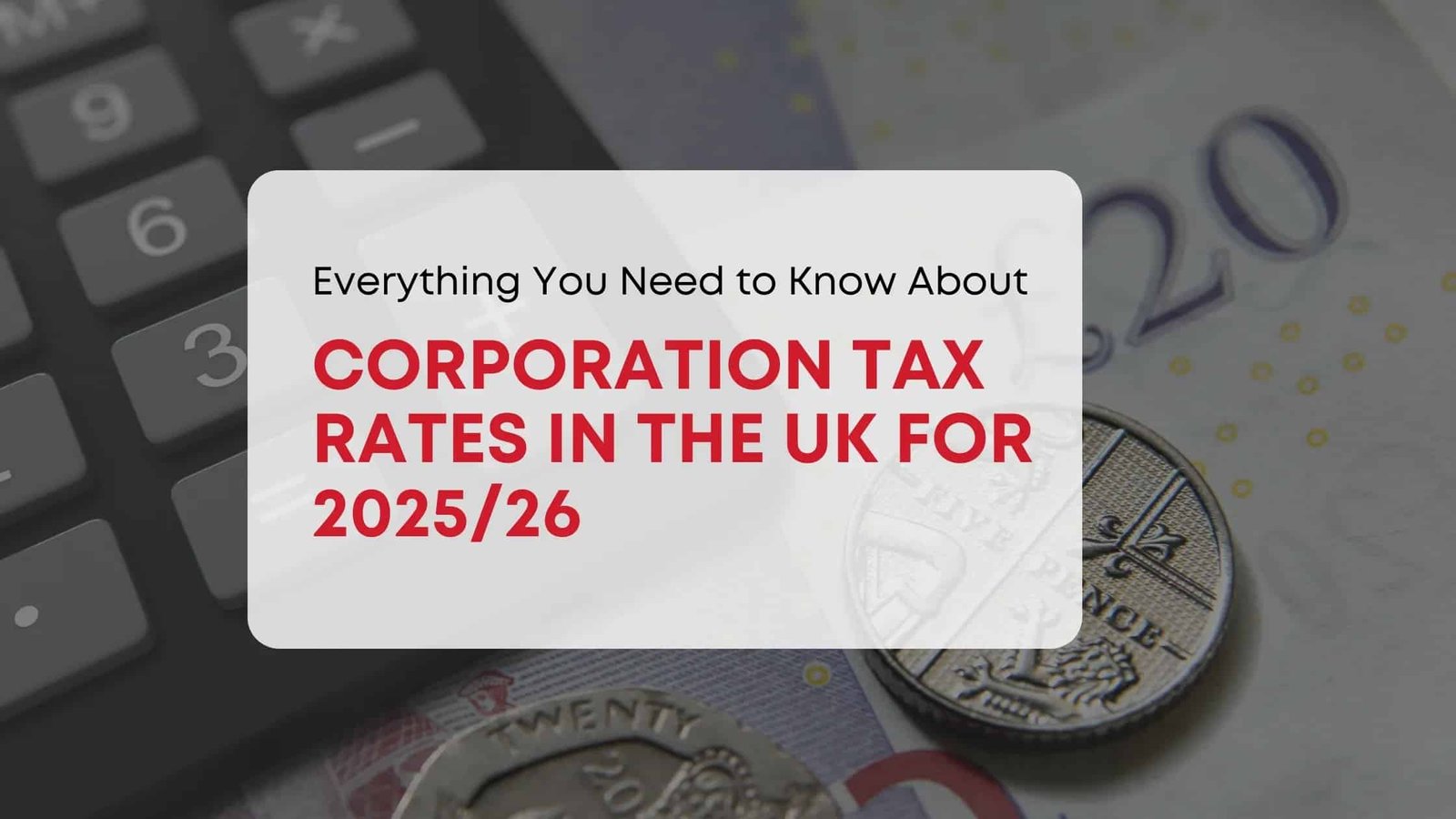Businesses in the UK must understand the corporation tax rates that will apply to various business profits for the 2025/26 financial year. Corporation tax is a direct tax that UK-based companies pay on their profits, and staying informed about the latest rates can significantly impact your business’s financial planning. For the 2025/26 financial year, the corporation tax structure remains mostly unchanged. However, the Small Profits Rate, Main Rate, and Marginal Relief are still key factors businesses need to consider when determining their tax obligations. This article will explain these tax rates in detail, how they affect businesses of all sizes, and provide practical insights into how companies can optimise their tax positions.
Overview of Corporation Tax in the UK for 2025/26
Corporation tax is a key part of running a business in the UK. It’s a tax on the money companies make. The 2025/26 financial year will not introduce any radical changes. The UK government’s focus will be on the Small Profits Rate, which will remain at 19% for businesses with profits up to £50,000. Understanding the precise tax rates for different profit levels is essential for business owners, financial managers, and accountants. Let’s break down the three primary categories of corporation tax in the UK for the 2025/26 financial year.
1. Small Profits Rate – 19% for Profits up to £50,000
The Small Profits Rate remains an important relief for smaller businesses, providing a lower tax burden for companies that earn up to £50,000 in profits. This rate ensures that small businesses are not disproportionately burdened by taxation, which is particularly crucial for start-ups or businesses in their early stages of growth.
The 19% rate will apply automatically to all businesses whose taxable profits are within this threshold. This helps companies to retain more of their earnings for reinvestment, growth, and development. This tax relief is a significant tool for supporting small businesses in the UK, encouraging entrepreneurial activities, and promoting economic growth at the grassroots level.
2. Main rate – 25% for Profits Over £250,000
For larger businesses with profits exceeding £250,000, the main rate of corporation tax is set at 25%. This rate applies to the majority of medium to large businesses in the UK. It reflects the scale of their operations and ensures that the taxation system is progressive, with larger corporations contributing a more substantial share of tax revenue.
Business owners and CFOs need to stay aware of the corporation tax rate, as managing profits wisely can help reduce tax bills. If a company’s profits are close to or above £250,000, careful tax planning is especially important to avoid surprise costs.
3. Marginal Relief – A Tapered Tax Rate for Profits Between £50,001 and £250,000
Businesses with profits between £50,001 and £250,000 qualify for Marginal Relief, which gradually increases the tax rate from 19% to 25%. This helps ease the shift from the Small Profits Rate to the Main Rate. The Marginal Relief is designed to ensure that businesses just over the £50,000 threshold do not face a steep tax increase as they grow.
The Marginal Relief operates by calculating a specific relief amount based on a formula, which reduces the overall tax rate applied to profits between £50,001 and £250,000. The rate progression is designed to ease the tax transition for businesses moving into larger operational territories.
Ring Fence Companies and Their Corporation Tax Rates
UK tax rules have a special provision for ring fence companies. These are businesses that extract oil or gas from the UK Continental Shelf or are involved in certain natural resource activities. These businesses face a different set of tax rates due to their specialised operations and the revenue they generate.
What Are Ring Fence Companies?
Ring fence companies are those whose operations are primarily focused on oil and gas extraction within the UK Continental Shelf. These companies are subject to a different taxation regime due to the nature of their work and the significant revenues they generate. These businesses are not eligible for the same tax allowances as other UK businesses. Instead, they face higher corporation tax rates, which are designed to reflect the large profits from extracting valuable natural resources.
Ring Fence Tax Rates for 2025/26
The tax rates for ring fence companies are as follows:
- Small Ring Fence Profits Rate: 19% for profits up to £50,000.
- Main Ring Fence Profits Rate: 30% for profits exceeding £250,000.
- Marginal Relief: This applies between £50,001 and £250,000, with the tax rate gradually increasing from 19% to 30%.
These higher rates reflect the substantial profits from oil and gas extraction, ensuring that these companies contribute significantly to public finances.
Key Deadlines for Corporation Tax Filings in 2025/26
Corporation tax payments in the UK are due nine months and one day after the end of the accounting period. For example, if your financial year ends on March 31, 2025, the payment would be due on January 1, 2026. Businesses must also submit their tax returns within 12 months after the end of the accounting period. Missing tax filing or payment deadlines can result in penalties, interest, or even legal action. That’s why businesses need to stay organised and meet deadlines to avoid extra costs. Keeping good records and using accounting software can make the process easier.
How to Reduce Your Corporation Tax Bill in 2025/26
Although paying taxes is a legal obligation, businesses can still take steps to minimise their tax liabilities through strategic planning.
1. Maximising Tax Reliefs and Allowances
Several tax reliefs are available to reduce corporation tax liabilities, including:
- Allowable Business Expenses: Make sure to claim for legitimate business expenses like office supplies, marketing costs, and utilities.
- Research and Development (R&D) Tax Relief: Businesses engaged in innovation can claim R&D tax relief to reduce their taxable income.
- Capital Allowances: Businesses can claim allowances for capital investments, including machinery and equipment.
2. Tax Efficient Profit Planning
Structuring profits and dividends in a tax-efficient way is essential for businesses with profits in the Marginal Relief band. Business owners should think about talking to tax experts and also determine the most tax-efficient way to distribute profits and dividends, taking advantage of allowances, reliefs, and exemptions.
Other Key Tax Changes in the UK for 2025/26
In addition to corporation tax, several other tax changes will impact UK businesses in 2025/26.
- National Insurance and Dividend Allowance Changes: The reduced Dividend Allowance of £500 means that individuals will face higher taxes on dividend income. Additionally, changes to National Insurance rates may impact both business owners and employees.
- Full Expensing and Annual Investment Allowance (AIA): Companies can benefit from the £1 million Annual Investment Allowance (AIA) limit, which allows them to write off the full cost of qualifying assets in the year of purchase. This provides immediate relief for businesses investing in machinery, equipment, or IT systems.
Typical Mistakes to Avoid When Filing Corporation Tax
Failing to Account for Associated Companies
Many businesses overlook the impact of associated companies on their tax calculation. If your company is part of a group of companies, the profits and thresholds might be shared, affecting your corporation’s tax liability.
Missing Out on Tax Reliefs
It’s easy to miss out on available tax reliefs, such as R&D tax credits or capital allowances. Business owners should make sure they understand the tax reliefs they qualify for and claim them properly.
Final Thoughts
The UK corporation tax rates for 2025/26 remain largely unchanged, providing businesses with stability. Small businesses pay 19%, while larger ones pay 25%. Businesses with profits between £50,000 and £250,000 benefit from Marginal Relief, which eases the tax rate increase. Staying on top of filing deadlines, using available tax reliefs, and planning carefully can help reduce tax bills. To be ready for the 2025/26 financial year, consider booking a free consultation with our professional tax expert, who can help you get the best tax outcome.





